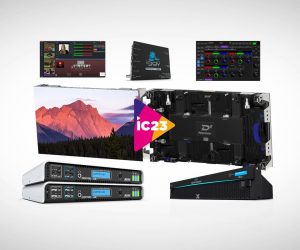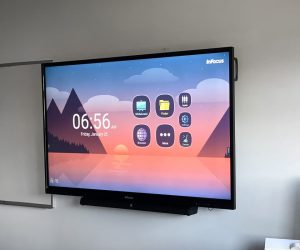
Rocket Surgery
The Victorian Heart Hospital takes AV-over-IP very seriously indeed, and it’s helping to train the doctors of tomorrow.
Text:/ Christopher Holder
Training surgeons has always been as important as it has been problematic. We’ve all seen those old paintings of the master surgeon slicing into some poor semi-conscious sod with an in-the-round audience of trainees leaning in from tiered theatre seating.
Thankfully, technology has replaced the need for an in-person spectacle (in the main). The systems within an operating system are specialised and battle hardened. Networked AV now makes it possible to reliably deliver the content from the operating room and make it available in realtime (or for later examination) anywhere with an internet connection.
This is the lens by which you can look at Australia’s newest training hospital: the Victorian Heart Hospital on the grounds of Monash University’s main campus in Melbourne’s east. As the name suggests, it’s a specialised centre providing a multi-disciplinary approach to heart health. The technology combines state-of-the-art medical tech with the best the commercial AV industry has to offer, together providing the maximum opportunity for the best outcomes for clients but also the best teaching opportunities for the doctors of tomorrow.


THEATRE OF OPERATIONS
Like most teaching hospitals, VHH is attached to a university. In this case Monash Uni.
Citadel Technology, which won the AV integration and installation tender, has been working with Monash University for a number of years.
The AV throughout the $564m hospital weaves its way through the operating theatres, boardroom, meeting spaces, the main lecture theatre, labs, and teaching spaces.
“Our experience working on the New Royal Adelaide Hospital helped us here,” observed Citadel Technology’s Director of Sales, Simon Purcell. “That said, VHH stretched us in new and interesting ways.”
On this project, Citadel Technology was responsible for the AV of all the spaces within the VHH hospital. This included the education spaces (which is a Citadel Technology sweetspot, owing to the extensive work done with Monash uni and others), the hospital’s conference and meeting rooms along with the clinical environments.
“Having the clinical areas as part of the tender and not just the meeting and conference rooms was a challenge but one that we knew we could successfully complete. Providing the systems for the operating theatres and laboratories put us on a learning curve. They involved some very specific requirements that are more complicated than your typical corporate AV space. So, we had to up-skill to master that aspect of it. The result was one that the client was very happy with.”
NUCLEUS MEDICINE
There are a number of AV hero products in the new-build but it’s impossible to talk about VHH and not talk about Sony Nucleus. Back in 2016, Sony Europe acquired eSaturnus, a Belgium-based company that provided clinical IP-based solutions in the medical field. The result is the Nucleus video-over-IP solution, designed specifically for hospitals. It takes care of a hospital’s video and patient data capture, recording and sharing of content throughout the facility. The system is mediated via a user-friendly touchscreen UI that allows staff to route surgical video and patient information from just about any source to any destination in the hospital. Nucleus uses standard IP network connections making it more cost effective and easily scalable.
“Sony Nucleus has two main use cases,” explains Simon Purcell. “The first is that it does all the clinical video routing inside the theatre. It means staff can plug in any medical device to the room and it can be displayed anywhere on any of the screens in the room. This is done at a very high bandwidth, as you can imagine, as detail is everything in an operating theatre.
“The second aspect is that it’s also designed natively to be viewed outside the theatre on the network.
“It’s a bit different to other video-over-IP systems because it’s tightly integrated with the hospital’s patient files.”


USE CASE
Alongside Nucleus video-over-IP runs Crestron NVX for all video-over-IP not derived from the operating theatres, while Dante takes care of networked audio in all the spaces. The hospital system spec differs somewhat to the Monash Uni spaces’ spec, which has been settled over many years, by Monash Uni’s lead AV architect, Peter Maclean.
“Almost everything is on the network,” explains Citadel Technology project manager, Andrew Rickell. “Every input and output, every audio devices is on the network, thanks to Dante, every DSP and amplifier is on the network from a traffic perspective or from a control perspective, along with the multicast traffic for audio and video.”
To paint a picture, let’s follow a likely AV scenario at VHH: An important surgery is to be ‘broadcast’ and recorded. The operating theatre has a full complement of installed AV to accommodate this without medical staff lifting a finger. Sony PTZ cameras complement in-room video provided by any other specialised medical instruments; a Shure shotgun mic above the main surgical display along with Audix ceiling-mounted gooseneck mics capture the audio (or Shure ULX-D beltpacks and lavalier mics can be used instead); while Community in-ceiling loudspeakers allow those at the far end of the ‘call’ to communicate with the medical team (or provide BGM or the like); behind the scenes, Biamp Tesira DSP works its magic to optimise intelligibility. There’s an AV control station on the other side of the OR’s window, which allows an operator to assist but in most cases the system can look after itself. A large Crestron touchpanel gives the surgeon the control they need (switching the system on/off, volume of mics and speakers up/down, etc).
Elsewhere in the building, in one of the Monash Uni teaching spaces, the Nucleus operating theatre footage can be displayed on one or all of the Sony 98-inch displays. The academic runs the class the usual way, relying on Shure ULX-D wireless (including a pair of ULX-D wireless gooseneck mics per studio desk) and ClearOne DSP for two-way communication.

THEATRE SHOWCASE
One of the jewels in the VHH crown is the theatre. The state-of-the-art hospital facility will handle all manner of in-house/out-of-house duties. Two hefty Sony 4K projectors generate a massive image on the front wall (equivalent to two 240-inch images). “It proved to be quite a lot for the builder handle,” recalls Citadel Technology project manager, Robert Henriksson. “It’s such a large area and very difficult to ensure it’s absolutely flat and smooth. I think they needed to give it five coats of paint!”
Community two-way column loudspeakers provide high quality audio and good mid/high pattern control. It’s more than a voice lift system, in anticipation of the theatre playing host to high-energy presentations and/or Ted-style lectures.
Sony PTZ cameras have preset zones to hone in on during lecture capture and VC.
A Williams AV IR-based system takes care of the hearing augmentation requirements.
The lectern is festooned with more than the usual complement of control interfaces — VC control, Sony Nucleus, general Crestron AV systems control, and a touchpad to control the motorised blinds. There are a number of AV floor boxes to provide flexibility in the position of the lectern.

THE AV BRIEF: UT CONSULTING
UT Consulting, the State Technology Advisor for the Victorian Heart Hospital and the designer of the hospital’s AV system, adopted a performance-based design approach for the audio visual system to meet the functional and technical requirements of the hospital. UT Consulting emphasised the creation of a flexible, state-of-the-art system with a focus on the auditorium, which serves as the ‘heart’ of the building. The auditorium is designed to facilitate teaching and allow for two-way communication between clinical theatres, labs, and clinicians.
UT Consulting designed the AV systems in clinical spaces to use a network-based solution that allows each space to operate independently while being capable of connecting to other locations within the hospital. This includes the capability for clinicians to view clinical procedures remotely from their offices. The AV systems in clinical spaces are designed to be auxiliary to the major medical equipment, such as the cath lab provider, with appropriate system redundancy in place to ensure continued operation.
To ensure alignment with Monash Health’s operational requirements and support model, the non-clinical systems within the hospital have been designed to align with their existing systems. Similarly, the education spaces have been designed to align with Monash University’s existing system types and support model.
Overall, UT Consulting’s design philosophy for the AV systems in the Victorian Heart Hospital prioritises flexibility, state-of-the-art technology, and seamless integration with existing systems and support models, in line with Monash Health’s operational requirements and support model.
UT Consulting: www.utconsulting.com.au
BOARDROOM
The VHH boardroom will double as a ‘situation’ room in case of emergency. A pair of Shure MXA910 Microflex arrays in the ceiling, along with Community in-ceiling speakers, partnered with Biamp Tesira DSP, make light work of audio in the room. Two large NEC 98-inch displays are the focal point. A single Logitech PTZ camera sits under the screens while a WilliamsAV IR emitter provides hearing assist.
“The Shure Microflex microphone arrays are installed throughout VHH,” explains Robert Henriksson. “They’re very easy to fit and easy to integrate. Thanks to Dante, there’s only one network cable out of the ceiling tile into the DSP.”
The Shure MX910 control GUI helps Citadel’s engineers to match the microphone array to the space and the likely complement of participants — with settings such as the height of the space and tightness of the channel width. There are eight assignable lobes for optimal pickup of participants in the room. In a boardroom, those lobes can be positioned and then locked off, or you can elect for any of the lobes to operate in Autofocus mode, to fine-tune each lobe’s position in real time, even if meeting participants lean back or stand up and pace the room.
“The Shure MX910s are really well suited to the training rooms,” continues Robert Henriksson. “Those spaces have flexible furniture and will get reset all the time, but the Shure mic array’s Autofocus mode means they’ll get the best results regardless — no need for a tech to reset the room or roll out tabletop mics.”


Monash Uni has standardised on Shure ULX wireless in a huge way, with around 3500 channels on site.
WIRELESS: VITAL SIGNS
The VHH building may effectively have two ‘tenants’ — Monash Uni and Monash Health — but it made sense to standardise on certain technology platforms. One of those platforms was Shure microphones, especially Shure wireless.
“When Semester One kicks off in 2023 we’ll have 3500 channels of Shure wireless across the campus,” deadpans Monash University’s Lead AV Architect, Peter Maclean. “The largest fleet of ULX-D in the world.
“When I arrived at the uni 11 years ago, we had 100 channels of Chiayo and a lot of our equipment was very antiquated. AV is so crucial to proper communication and connection, and selecting the right microphones is important to get right. Having a high quality microphone to start with, means you start with high quality audio. But it’s also the transmission. The digital wireless of ULX-D means that you have very little loss. There’s no compansion like you’d find in all the older system, so you’re getting a much cleaner signal.
“Furthermore, we had to successfully deploy hundreds of channels without interference. For example, in one of our larger spaces we have more than 50 Shure ULX-D wireless gooseneck microphones in there. They all work perfectly together. Our learning teaching building has over 300 wireless microphones. None of them interfere with each other. We can do that thanks to Shure’s high density mode and the 256-bit encryption which ensures transmitters in one Group can’t be picked up by a receiver in another Group.”
EQUIPMENT HIGHLIGHTS
- $2m of Sony Nucleus for Operating Theatres
- Shure Microphones & Wireless
- Biamp Tesira DSP
- Sony Projection, PTZ Cams & Displays
- Concierge Room Booking
- Crestron Control, NVX & DM
- Crestron Flex units for the VC meeting spaces
- Logitech VC Cameras
- WilliamsAV Hearing Augmentation


INVISIBLE & FLEXIBLE
If Covid is history’s biggest health system stress test, then the Victorian Heart Hospital is a formidable response. Thanks to flexibility of AV-over-IP, important information, techniques and procedures can be shared across the building or around world regardless of lockdowns or lockouts. AV systems are easy to use without specialised technicians and easy to remotely monitor.
“VHH was an interesting job,” muses Citadel Technology’s Andrew Rickell. “It allowed us to take technology and build it into the background to support surgeons and doctors in what it is they’re doing. It was our role to design and install systems that were virtually invisible yet super flexible. It was a real challenge but also a really fulfilling challenge when we pulled it off.”
John Holland (Main Contractor): johnholland.com
Citadel Technology: citadeltech.com.au
UT Consulting (VHH State Technology Advisor): utconsulting.com.au















RESPONSES